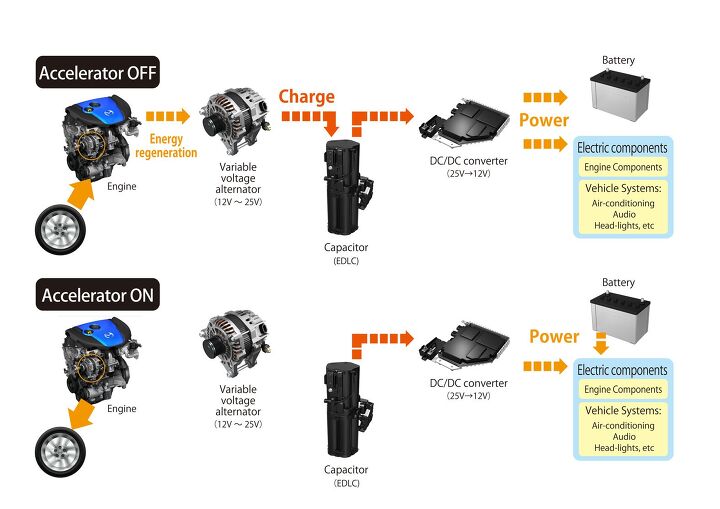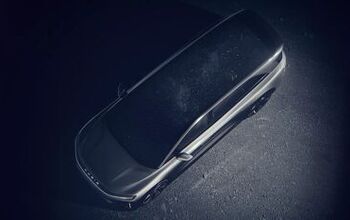Mazda Uses Capacitor To Save Gas

Toyota’s Chief Engineer Satoshi Ogiso figures that efficiency improvements of traditional gasoline engines may soon hit a wall. He gives the gasoline engine an improvement potential of “maybe 10 to 20 percent.” Today, we have proof that it is a fight of diminishing returns. Mazda is now at a point where it saves up to 10 percent of gas by idling the alternator. How is that done?
Mazda’s developed a regenerative braking system that uses a capacitor. Compared to batteries, a capacitor can be charged and discharged rapidly. Also, it does not wear out like a battery. Mazda stores the regenerated energy in the capacitor. It does not use it to power the car. That would need a hybrid system Mazda does not have. Also, even the new Electric Double Layer Capacitor (EDLC) Mazda uses would not get you far. Instead, Mazda uses the electricity to power the climate control, the audio system and other gizmos in the car that want electric power. As we know, the gizmos proliferate with abandon. And why does that save gas?
The electric power generated by the car’s alternator does not come free. The alternator demands power from the engine. As a rule of thumb, 5 hp are usually used, however, this changes with the amperage and type of the alternator.
Mazda calls its system “i-ELOOP.” It comes from “Intelligent Energy Loop.
The system uses a new 12-25V variable voltage alternator, a low-resistance electric double layer capacitor and a DC/DC converter. ‘i-ELOOP’ starts to recover kinetic energy the moment the driver lifts off the accelerator pedal and the vehicle begins to decelerate. The variable voltage alternator generates electricity at up to 25V for maximum efficiency before sending it to the Electric Double Layer Capacitor (EDLC) for storage. The capacitor can be fully charged in seconds. The DC/DC converter steps down the electricity from 25V to 12V before it is distributed directly to the vehicle’s electrical components. The system also charges the vehicle battery as necessary. Says Mazda:
“As a result, in ‘stop-and-go’ driving conditions, fuel economy improves by approximately 10 percent.”
The system will begin to appear in Mazda vehicles in 2012.
Mazda does not have hybrid technology and instead is betting on optimizing the ICE with Mazda’s Skyactiv Technology and other fuel saving tricks. As we see, the engineers have to get very creative to save a few more drops.

Bertel Schmitt comes back to journalism after taking a 35 year break in advertising and marketing. He ran and owned advertising agencies in Duesseldorf, Germany, and New York City. Volkswagen A.G. was Bertel's most important corporate account. Schmitt's advertising and marketing career touched many corners of the industry with a special focus on automotive products and services. Since 2004, he lives in Japan and China with his wife <a href="http://www.tomokoandbertel.com"> Tomoko </a>. Bertel Schmitt is a founding board member of the <a href="http://www.offshoresuperseries.com"> Offshore Super Series </a>, an American offshore powerboat racing organization. He is co-owner of the racing team Typhoon.
More by Bertel Schmitt
Latest Car Reviews
Read moreLatest Product Reviews
Read moreRecent Comments
- 28-Cars-Later WSJ blurb in Think or Swim:Workers at Volkswagen's Tennessee factory voted to join the United Auto Workers, marking a historic win for the 89- year-old union that is seeking to expand where it has struggled before, with foreign-owned factories in the South.The vote is a breakthrough for the UAW, whose membership has shrunk by about three-quarters since the 1970s, to less than 400,000 workers last year.UAW leaders have hitched their growth ambitions to organizing nonunion auto factories, many of which are in southern states where the Detroit-based labor group has failed several times and antiunion sentiment abounds."People are ready for change," said Kelcey Smith, 48, who has worked in the VW plant's paint shop for about a year, after leaving his job at an Amazon.com warehouse in town. "We look forward to making history and bringing change throughout the entire South." ...Start the clock on a Chattanooga shutdown.
- 1995 SC Didn't Chrysler actually offer something with a rearward facing seat and a desk with a typewriter back in the 60s?
- The Oracle Happy Trails Tadge
- Kwik_Shift_Pro4X Union fees and corruption. What can go wrong?
- Lou_BC How about one of those 2 foot wide horizontal speedometers out of the late 60's Ford Galaxie?


































Comments
Join the conversation
Alternators are only about 40% efficient at typical operating conditions. Even so I agree, 5 hp is a lot. Switch all the electrics off in your car at idle, note the fuel consumption on that handy little readout you never look at. Now switch everything on (not the AC). It'll bump up by maybe 0.04 gallons per hour. That ain't 5 hp.
Most of these "breakthroughs" seem to be expensive solutions to miniscule problems. The cost of all these systems just so you can put a less powerful alternator and save 1-2 horsepower from electricity production? To the average motorist, your talking pennies a week in saved fuel costs, only to be offset by thousands more tacked on to the cost of a new vehicle for such an elaborate system, and let's not even get started on what these dealer-only type repairs and parts are going to be in the future when they eventually wear out.